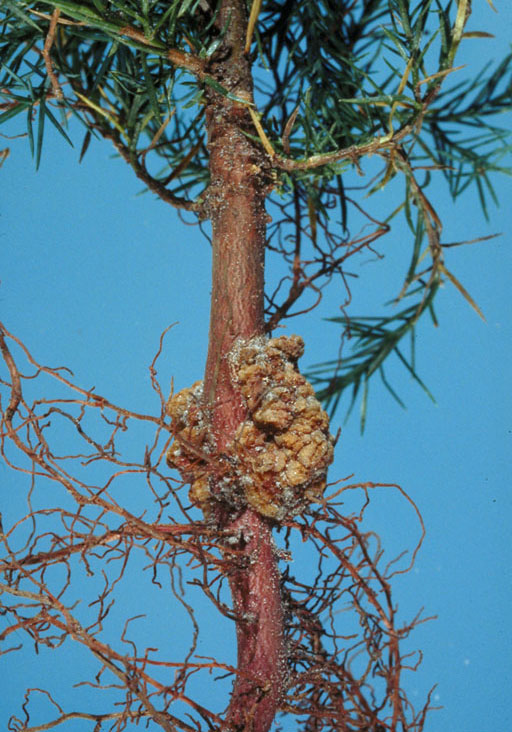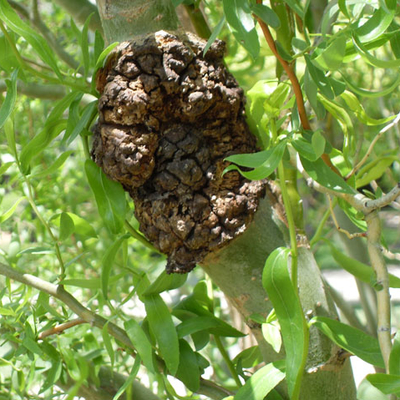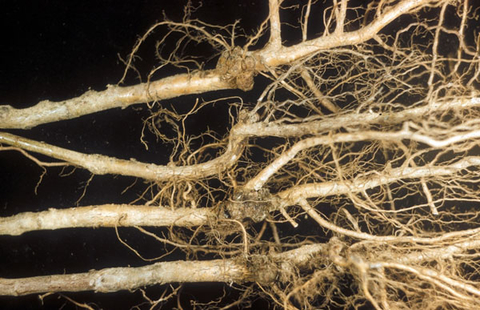Quick facts
-
Crown gall causes rough, woody, tumor-like galls to form on roots, trunks and occasionally branches of many different trees and shrubs.
-
Galls can interrupt the flow of nutrients and water within the tree, reducing overall plant growth and vigor.
-
Young plants with many galls, and plants with a gall completely encircling the main stem, are the most severely affected and can be killed by the disease.
-
Mature trees often tolerate many galls with few negative effects.
-
Plants with crown gall are more susceptible to drought stress, winter injury and secondary diseases that enter the plant through cracks in the gall.
How to identify crown gall
Irregular tumor-like growths called galls are found on stems and roots. They range in size from 1/10 inch up to 1 foot in diameter.
New galls are round, rough textured, light colored and may be smooth and slightly spongy.
Older galls become hard and dry. They are often dark in color with many rough cracks and fissures.
Galls are commonly found on the main stem at the point where the stem enters the soil.
Galls also form on roots.
In some plant species, rows of galls form along stems or branches.
Plants commonly affected by crown gall in Minnesota
Crown gall can affect more than 600 different species of plants worldwide including many common vegetables, weeds, trees and shrubs.
In Minnesota, crown gall caused by Agrobacterium tumefaciens is most commonly seen on:
Roses (Rosa spp.)
Willow (Salix spp.)
Poplar (Populus spp.)
Fruit trees like apple (Malus spp.), cherry, plum or apricot (Prunus spp.)
Two other species of Agrobacterium cause woody galls to form on susceptible plants.
Agrobacterium vitis causes woody galls to form on grape vines.
Brambles like raspberry may have gall formation along their canes when infected with Agrobacterium rubi.
How does crown gall survive and spread
- Crown gall is caused by the bacterial plant pathogen, Agrobacterium tumefaciens.
- Crown gall bacteria enter plant roots through wounds.
- Wounds may have been created by planting, grafting, soil insect feeding, root damage from excavation or other forms of physical damage.
- The wounded roots release chemicals which attract the bacteria.
- Cells that are newly wounded are prone to bacterial infection for a few days during the growing season to several months if the plant is dormant.
- The crown gall bacteria cause the plant cells to divide uncontrollably and grow to unusually large sizes. A visible gall can be seen in 2-4 weeks during the growing season.
- Over time the bacteria create secondary galls which contribute to the asymmetrical shape of the galls.
- In some plants like rose, willow and poplar, the bacteria may move internally up into stems and branches, initiating galls above ground.
- Galls may also form on pruning cuts or wounds in stems or branches if the bacteria are introduced into the wound through rain splashed soil or contaminated pruning tools.
- Over time, galls begin to decay and breakdown. The bacteria return to the soil where they can be further dispersed by water or equipment.
- Crown gall bacteria survive for many years in soil and by colonizing roots of many different plants in the landscape.
- Crown gall bacteria are most commonly moved to new locations on the roots of infected plants but can also be moved on contaminated soil.
How to manage crown gall
Preventing crown gall
Prevention is the best method of control because once established in an area, the crown gall bacteria can be very difficult to eliminate.
Check all new plants carefully.
Do not plant any tree or shrub with galls on the roots or stems.
Pay extra attention when planting roses, fruit trees, poplar or willows.
The biological control bacteria Agrobacterium radiobacter K-84 can be used to protect trees and shrubs from crown gall infection during planting.
Dip roots of bare root plants or drench potted plants with a solution of water and biological control bacteria, Agrobacterium radiobacter K-84.
These bacteria protect roots by producing an antibiotic.
They also cover wound sites that the crown gall bacteria would use to start an infection.
Galltrol is a commercial formulation of A. radiobacter K-84 that is registered for use in Minnesota.
If you notice crown gall on your trees and shrubs
On a recently planted tree or shrub:
Dig up the plant and the soil immediately around the roots and dispose of it.
Do not add infected plant material to compost piles.
Burning is the best way to dispose of infected woody plants.
On established trees and shrubs:
Established trees and shrubs can tolerate infection with crown gall and can be left in the landscape.
Make sure to disinfect pruning tools with a 10-percent solution of household bleach after using them to prune crown gall infected trees.
If infected plants exist on your property, avoid planting highly susceptible species like rose, willow, poplar and fruit trees.
Reviewed in 2024





